Updated Electrical Machines MCQs – Synchronous Generators MCQs ( Electrical Machines ) MCQs
Latest Electrical Machines MCQs
By practicing these MCQs of Synchronous Generators MCQs ( Electrical Machines ) MCQs – Latest Competitive MCQs , an individual for exams performs better than before. This post comprising of objective questions and answers related to “Synchronous Generators MCQs ( Electrical Machines ) Mcqs “. As wise people believe “Perfect Practice make a Man Perfect”. It is therefore practice these mcqs of Electrical Machines to approach the success. Tab this page to check “Synchronous Generators MCQs ( Electrical Machines )” for the preparation of competitive mcqs, FPSC mcqs, PPSC mcqs, SPSC mcqs, KPPSC mcqs, AJKPSC mcqs, BPSC mcqs, NTS mcqs, PTS mcqs, OTS mcqs, Atomic Energy mcqs, Pak Army mcqs, Pak Navy mcqs, CTS mcqs, ETEA mcqs and others.
Electrical Machines MCQs – Synchronous Generators MCQs ( Electrical Machines ) MCQs
The most occurred mcqs of Synchronous Generators MCQs ( Electrical Machines ) in past papers. Past papers of Synchronous Generators MCQs ( Electrical Machines ) Mcqs. Past papers of Synchronous Generators MCQs ( Electrical Machines ) Mcqs . Mcqs are the necessary part of any competitive / job related exams. The Mcqs having specific numbers in any written test. It is therefore everyone have to learn / remember the related Synchronous Generators MCQs ( Electrical Machines ) Mcqs. The Important series of Synchronous Generators MCQs ( Electrical Machines ) Mcqs are given below:
Phasor Diagram of a Cylindrical Rotor Alternator
1. The flux addition is due to ______________
(i) sinusoidal distribution of mmfs
(ii) zero relative velocity between two mmfs
(iii) spatial distribution of three phases by 120°
a) (i), (ii)
b) (i), (ii), (iii)
c) (iii)
d) (ii), (iii)
Answer: a
Explanation: Flux addition in ac machines is due to sinusoidal flux distribution and they must be stationary with respect to each other.
2. If the resultant flux will not be in phase with the resultant mmf Fr. This is due to __________
a) hysteresis effect
b) armature reaction
c) hysteresis effect and armature reaction
d) eddy currents
Answer: a
Explanation: Hysteresis effect causes the flux to be lagging in nature.
3. The internal power factor angle Ψ is between __________
a) Ef and Ia
b) Ia and field flux
c) Ef and Vt
d) Vt and Ia
Answer: a
Explanation: 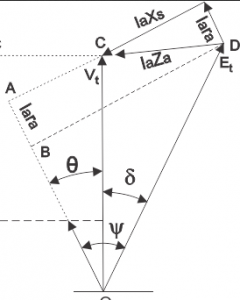
4. The load angle δ is between __________
a) Ef and Ia
b) Ia and field flux
c) Ef and Vt
d) Vt and Ia
Answer: c
Explanation: It is the angle between excitation voltage and the terminal voltage.
5. If it is assumed that the iron part of magnetic circuit requires zero mmf, relation between Ef and If will be __________
a)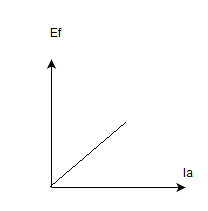
b)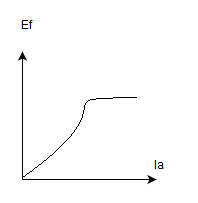
c)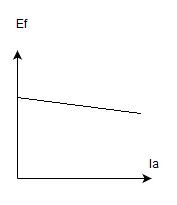
d)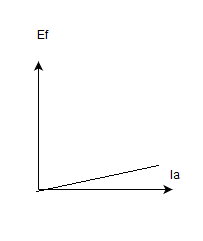
Answer: a
Explanation: There will be linear relation in Ef and Ia as mmf required is zero.
6. Phasor diagram below is best describing the __________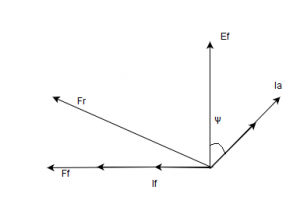
a) Open circuit characteristic of alternator
b) Short circuit characteristic of alternator
c) External circuit characteristic of alternator
d) Internal circuit characteristic of alternator
Answer: a
Explanation: Graph of Ef vs Ff is the open circuit characteristic of the machine.
7. The short circuit characteristic of alternator is a straight line due to __________
a) no saturation
b) no armature reaction
c) no eddy current
d) all of the mentioned
Answer: a
Explanation: At the short circuit of the alternator is having the linear relation as the armature does not enter the saturation mode due to demagnetizing nature of armature reaction.
8. From the OCC and SCC curves, what does the intercept AB represent?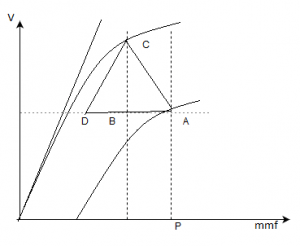
a) Armature reaction
b) Leakage reactance
c) Armature copper losses
d) Sum of armature reaction and leakage reactance
Answer: a
Explanation: It is armature reaction which is calculated based on Potier triangle.
9. From the OCC and SCC curves, what does the intercept BC represent?
a) Armature reaction
b) Leakage reactance
c) Armature copper losses
d) Sum of armature reaction and leakage reactance
Answer: b
Explanation: It is leakage reactance which is calculated based on potier triangle.
10. The leakage reactance can be determined with lesser accuracy by using Potier triangle.
a) True
b) False
Answer: b
Explanation: The leakage reactance can be determined with better accuracy by using Potier triangle.
11. Potier method is very accurate due to __________
a) emfs are handled as voltage and mmf as AT
b) emf and mmf are handled as AT
c) emf and mmf are handled as voltage
d) none of the mentioned
Answer: a
Explanation: The potier’s method is very accurate because emfs are handled as voltage and mmf as AT.
12. Choose the correct representation for the time phasor below.
a) 
b) 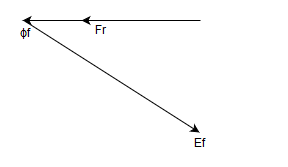
c) 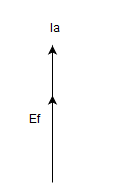
d) all of the mentioned
Answer: d
Explanation: It is the angle between excitation voltage and the armature current.
Voltage Regulation of an Alternator
1. When the load on an alternator is varied, its terminal voltage also changes due to _____________
a) armature resistance
b) leakage reactance
c) armature reaction
d) all of the mentioned
Answer: a
Explanation: Armature reactance, leakage reactance and armature reaction cause the terminal voltage to differ from the excitation voltage.
2. Voltage regulation for the alternator operating at leading power factor is negative.
a) True
b) False
Answer: a
Explanation: Voltage regulation for an alternator operating at leading power factor is negative due to magnetizing nature of armature reaction.
3. Voltage regulation for an alternator operating at leading power factor is negative due to ___________
a) magnetizing nature of armature reaction
b) demagnetizing nature of armature reaction
c) cross-magnetizing nature of armature reaction
d) all of the mentioned
Answer: a
Explanation: Field flux gets aided by the armature reaction leading to higher Vt.
4. Alternator on infinite bus bar has constant ___________
a) terminal voltage and frequency
b) frequency
c) power factor
d) power factor and terminal voltage
Answer: a
Explanation: Infinite bus bar has constant voltage and frequency.
5. The emf method of the voltage regulation is applicable only to cylindrical rotor alternator due to ___________
a) resultant air gap flux is not affected by angular position of rotor
b) uniform angular position of rotor
c) non uniform angular position of rotor
d) saliency of the poles is a trouble while estimating the emf
Answer: a
Explanation: It is so because resultant air gap is unaffected by rotor position.
6. Emf method is also known as ___________
a) pessimistic method
b) optimistic method
c) zero power factor method
d) none of the mentioned
Answer: a
Explanation: Unsaturated impedance is greater than saturated impedance, so the drop accounted will be less than the actual making the voltage regulation more than actual.
7. In mmf method ___________
a) all the emf is scaled to mmf
b) only the mmf values are considered neglecting impedance drop
c) all the emf are taken zero
d) emf is converted to saturated impedance drops
Answer: a
Explanation: In mmf method all the emf is scaled to mmf
8. Mmf method of voltage regulation is called _______ while the emf method is __________
a) optimistic, pessimistic
b) pessimistic, pessimistic
c) optimistic, optimistic
d) pessimistic, optimistic
Answer: a
Explanation: In the mmf method the calculated value is lesser than the actual value so it is less misleading than emf method which predicts a greater value.
9. The preferred order of calculating the voltage regulation is ___________
a) ZPF > ASA > MMF > EMF
b) ZPF > MMF > ASA > EMF
c) ASA > MMF > ASA > EMF
d) EMF > ASA > ZPF > MMF
Answer: a
Explanation: Emf method is least preferred over the other methods and zpf method gives the accurate results as it does not alter the values.
10. In a calculation, the actual voltage regulation is 33.1% while the calculated value of the voltage regulation is 56.8%. This infers that the chosen method has been ___________
a) emf
b) mmf
c) asa
d) zpf
Answer: a
Explanation: As the given value is more than actual, so it must be emf method.
11. In a calculation, the actual voltage regulation is 33.1% while the calculated value of the voltage regulation is 25%. This infers that the chosen method has been ___________
a) emf
b) mmf
c) asa
d) zpf
Answer: b
Explanation: As the given value is less than actual, so it must be mmf method.
12. In a calculation, the actual voltage regulation is 33.1% while the calculated value of the voltage regulation is 32.9%. This infers that the chosen method has been ___________
a) zpf or asa
b) emf
c) mmf
d) mmf or zpf
Answer: a
Explanation: As the given value is very close to actual, so it must be zpf or asa method of regulation.
13. If the emf from the air gap line is the 3-phase alternator is 440V per phase and armature current is 110 A. The synchronous reactance is?
a) 4 ohms
b) 2 ohms
c) 6.92 ohms
d) 2.32 ohms
Answer: a
Explanation: Z = V/I = 440/110 = 4 ohms.
14. If the machine size increases, the three phase alternator resistance _______ and synchronous reactance _______
a) increases, decreases
b) decreases, increases
c) remains constant, decreases
d) decreases, decreases
Answer: a
Explanation: If the machine size increases, the copper amount will increase but the air gap will also increase having more reluctance so the reactance will reduce.
15. Ideally the voltage regulation of an alternator should be ___________
a) zero
b) infinite
c) 50%
d) 100%
Answer: a
Explanation: Ideally the terminal voltage and the excitation voltage should be same.
So V.R. = E-V/V = 0%.
Operating Characteristics of Alternators and their Ratings
1. A 315V, 3-phase 400 MVA alternator is running at no load at constant excitations. The most appropriate representation in space domain is?
a) 
b) 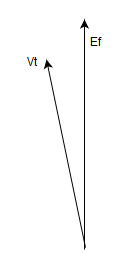
c) 
d) 
Answer: a
Explanation: At no load Ia = 0. So Ef = Vt.
2. A 315V, 3-phase 400 MVA alternator is running at lagging power factor at constant excitations. The most appropriate representation in space domain is?
a) 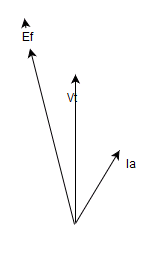
b) 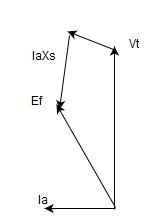
c) 
d) 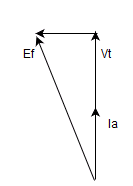
Answer: a
Explanation: Ia should lag Ef.
3. A 315V, 3-phase 400 MVA alternator is running at leading power factor load at constant excitations. The most appropriate representation in space domain is?
a) 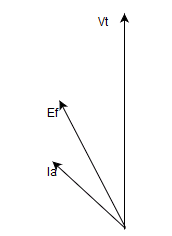
b) 
c) 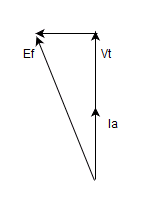
d) 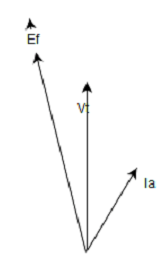
Answer: a
Explanation: Ia will lead the excitation.
4. A 315V, 3-phase 400 MVA alternator is running at unity power factor at constant excitations. The most appropriate representation in space domain is?
a) 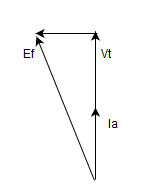
b) 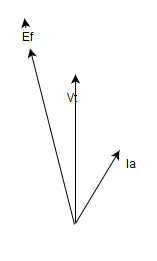
c) 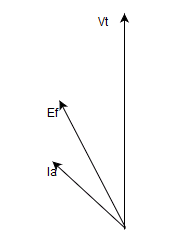
d) 
Answer: a
Explanation: Ia in phase with excitation voltage.
5. A 315V, 3-phase 400 MVA alternator is running at zero power factor lagging at constant excitations. The most appropriate representation in space domain is?
a) 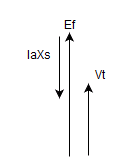
b) 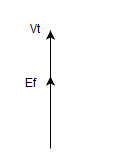
c) 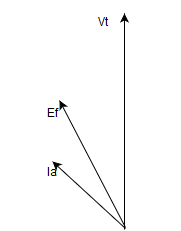
d) 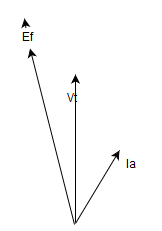
Answer: a
Explanation: Ia has to be lagging by 90°.
6. A 315V, 3-phase 400 MVA alternator is running at zero power factor leading at constant excitations. The most appropriate representaion in space domian is?
a) 
b) 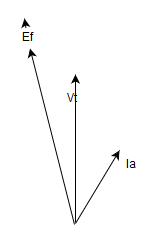
c) 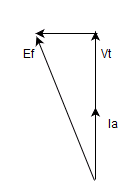
d) none of the mentioned
Answer: a
Explanation: Ia has to be leading by 90°.
7. With the alternator running at rated terminal voltage Vt, at rated current Ia = 1 per unit. What happens if load current is reduced to zero, if it was operating at lagging power factor?
a) 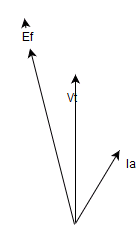
b) 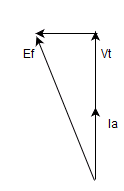
c) 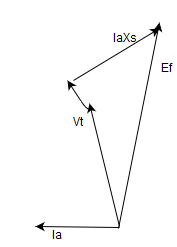
d) 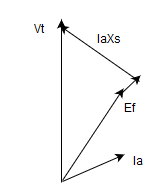
Answer: a
Explanation: Check for the Ia lagging Ef and Ef > Vt.
8. With the alternator running at rated terminal voltage Vt, at rated current Ia = 1 per unit. What happens if load current is reduced to zero, if it was operating at leading power factor?
a) 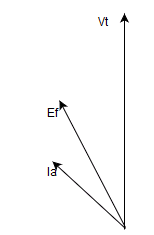
b) 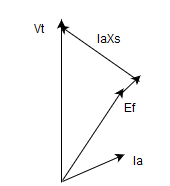
c) 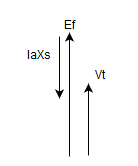
d) 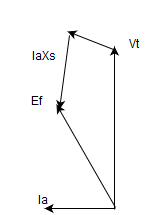
Answer: a
Explanation: Check for the Ia leading Ef and Ef < Vt.
9. If the machine was operating at upf, then the new excitation voltage will be _________
a) greater than 1 pu
b) less than 1 pu
c) 1 pu
d) zero
Answer: a
Explanation: The new excitation will be more than 1 pu to compensate for the flux required.
10. The variation of Vt vs Ia is for the alternator is given below.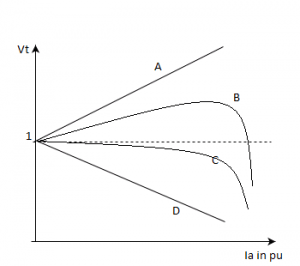
Choose the appropriate
a) A-zpf lead; B-0.8 lead; C-0.8 lag; D-zpf lag
b) A-zpf lag; B-0.8 lead; C-0.8 lag; D-zpf lead
c) A-zpf lead; B-0.8 lag; C-0.8 lead; D-zpf lag
d) A-zpf lead; B-0.8 lag; C-0.8 lead; D-zpf lag
Answer: a
Explanation: A is zpf lead for the alternator and D will be zpf lag.
11. Mark the plot for terminal voltage vs armature current for the alternator.
a) 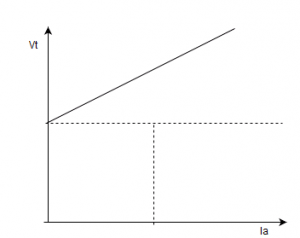
b) 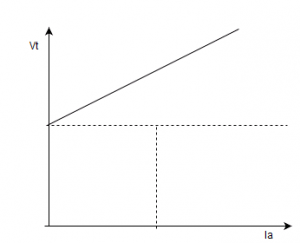
c) 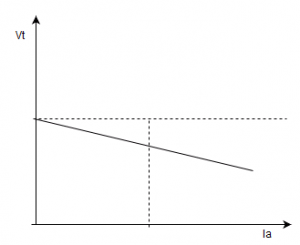
d) 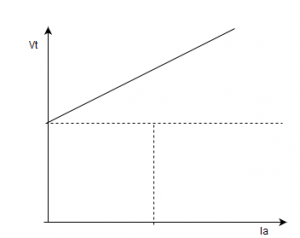
Answer: a
Explanation: After the maximum excitation the alternator will have a fall out if the excitation is increased beyond synchronous speed.
12. Alternator compounding characteristic is obtained by _________
a) keeping Vt constant
b) keeping Ef constant
c) keeping Ia constant
d) varying Vt
Answer: a
Explanation: Alternator compounding characteristic is obtained by keeping Vt constant.
13. At zpf lag, the excitation should be increased in order to maintain the armature terminal voltage constant.
a) True
b) False
Answer: a
Explanation: Due to demagnetizing armature reaction at zpf lag in an alternator.
14. The rating of the alternator is decided by _________
a) losses
b) voltage
c) armature current
d) temperature
Answer: a
Explanation: The losses determine the rating to be used for alternator.
15. The core losses in synchronous machine is _______ dependent.
a) voltage
b) current
c) temperature
d) insulation
Answer: a
Explanation: Core losses depend on the voltage applied to the machine.
Updated Electrical Machines MCQs – Synchronous Generators MCQs ( Electrical Machines ) MCQs
